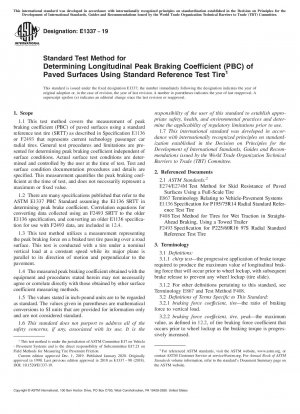ASTM E1337-19
Standard Test Method for Determining Longitudinal Peak Braking Coefficient (PBC) of Paved Surfaces Using Standard Reference Test Tire
- Standard No.
- ASTM E1337-19
- Release Date
- 2019
- Published By
- American Society for Testing and Materials (ASTM)
- Latest
- ASTM E1337-19
- Scope
- 1.1 This test method covers the measurement of peak braking coefficient (PBC) of paved surfaces using a standard reference test tire (SRTT) as described in Specification E1136 or F2493 that represents current technology passenger car radial tires. General test procedures and limitations are presented for determining peak braking coefficient independent of surface conditions. Actual surface test conditions are determined and controlled by the user at the time of test. Test and surface condition documentation procedures and details are specified. This measurement quantifies the peak braking coefficient at the time of test, and does not necessarily represent a maximum or fixed value. 1.2 There are many specifications published that refer to the ASTM E1337 PBC Standard assuming the E1136 SRTT in determining peak brake coefficient. Correlation equations for converting data collected using an F2493 SRTT to the older E1136 specification, and converting an older E1136 specification for use with F2493 data, are included in 12.4. 1.3 This test method utilizes a measurement representing the peak braking force on a braked test tire passing over a road surface. This test is conducted with a tire under a nominal vertical load at a constant speed while its major plane is parallel to its direction of motion and perpendicular to the pavement. 1.4 The measured peak braking coefficient obtained with the equipment and procedures stated herein may not necessarily agree or correlate directly with those obtained by other surface coefficient measuring methods. 1.5 The values stated in inch-pound units are to be regarded as standard. The values given in parentheses are mathematical conversions to SI units that are provided for information only and are not considered standard. 1.6 This standard does not purport to address all of the safety concerns, if any, associated with its use. It is the responsibility of the user of this standard to establish appropriate safety, health, and environmental practices and determine the applicability of regulatory limitations prior to use. 1.7 This international standard was developed in accordance with internationally recognized principles on standardization established in the Decision on Principles for the Development of International Standards, Guides and Recommendations issued by the World Trade Organization Technical Barriers to Trade (TBT) Committee.
ASTM E1337-19 Referenced Document
- ASTM E1136 Standard Specification for A Radial Standard Reference Test Tire
- ASTM E274/E274M Standard Test Method for Skid Resistance of Paved Surfaces Using a Full-Scale Tire*, 2020-06-01 Update
- ASTM E867 Terminology Relating to Vehicle-Pavement Systems
- ASTM F2493 Standard Specification for P225/60R16 97S Radial Standard Reference Test Tire*, 2023-09-01 Update
- ASTM F408 Standard Test Method for Tires for Wet Traction in Straight-Ahead Braking, Using a Towed Trailer
ASTM E1337-19 history
- 2019 ASTM E1337-19 Standard Test Method for Determining Longitudinal Peak Braking Coefficient (PBC) of Paved Surfaces Using Standard Reference Test Tire
- 2018 ASTM E1337-90(2018) Standard Test Method for Determining Longitudinal Peak Braking Coefficient of Paved Surfaces Using Standard Reference Test Tire
- 1990 ASTM E1337-90(2012) Standard Test Method for Determining Longitudinal Peak Braking Coefficient of Paved Surfaces Using Standard Reference Test Tire
- 1990 ASTM E1337-90(2008) Standard Test Method for Determining Longitudinal Peak Braking Coefficient of Paved Surfaces Using Standard Reference Test Tire
- 1990 ASTM E1337-90(2002) Standard Test Method for Determining Longitudinal Peak Braking Coefficient of Paved Surfaces Using a Standard Reference Test Tire
- 1990 ASTM E1337-90(1996) Standard Test Method for Determining Longitudinal Peak Braking Coefficient of Paved Surfaces Using a Standard Reference Test Tire
- 1990 ASTM E1337-90 Standard Test Method for Determining Longitudinal Peak Braking Coefficient of Paved Surfaces Using a Standard Reference Test Tire
